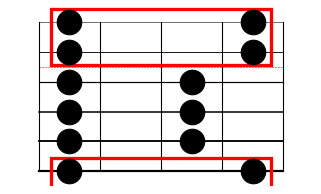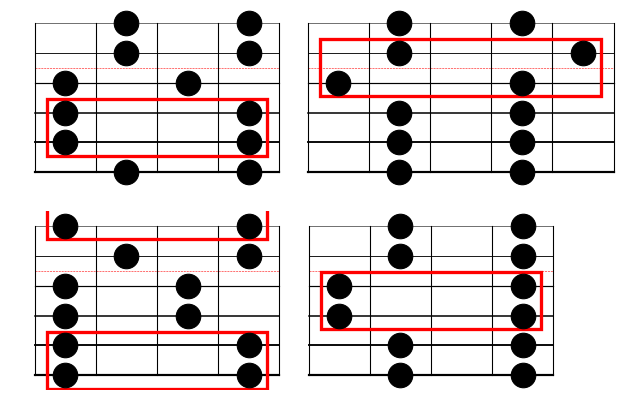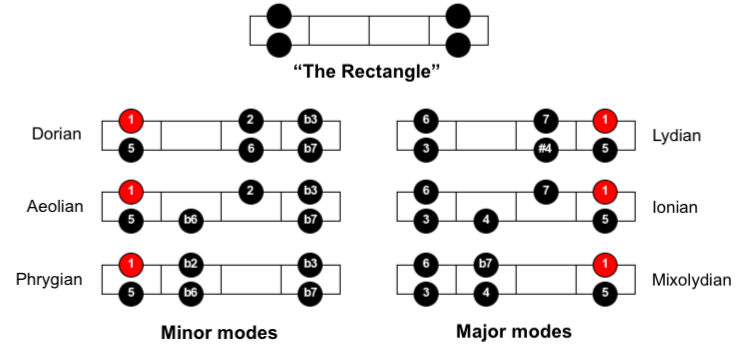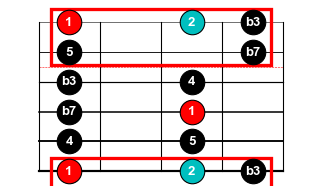The link between pentatonic scales and the diatonic modes has been staring you in the face all along. And it’s both the key to quickly pivoting from one scale to another and an easy way to add color to your pentatonic soloing.
Step 1: find the rectangle
Every “in-position” major/minor pentatonic fingering pattern has two adjacent strings with minor third intervals. We’ll call this “the rectangle”, for what I hope are obvious reasons. Here it is in the scale shape that every budding guitarist has tattooed on the back of their hand:

In the other pentatonic patterns, that rectangle moves to different pairs of strings, but it’s always there. Note that when “the rectangle” straddles the G and B strings, it becomes a parallelogram (see the geometry of standard tuning).

As an aside, back in high school, when you asked your geometry teacher “when am I ever going to use this in the real world”, the answer is now.
Step 2: fill in the box!
Changing a pentatonic (5 note) scale into one of the diatonic (7 note) modes requires adding…wait for it…two notes.
In the minor pentatonic scale, the missing notes are the 2nd and the 6th scale degrees, and in the major pentatonic scale, the missing notes are the 4th and 7th, as you can see in Figure 3.

It turns out there are three ways to fill in the missing notes that result in valid diatonic modes, and these notes always fall inside “the rectangle” in the pentatonic scale shape, as shown in Figure 4 (leg lock!…sorry, not sorry).

Hopefully, you can see where this is going. Figures 5-7 give you usable versions of six of the seven diatonic modes.



Step 3: there is no step 3!
Okay, okay, you’re probably wondering what happened to the Locrian mode. The short answer is…who cares? The slightly longer answer is that, because the Locrian mode has a diminished fifth (aka tritone), it doesn’t fit inside the pentatonic box. Sorry. If you’re playing 99.9% of rock and roll, you don’t really need the Locrian scale anyway. Half-diminished chords are for Berklee grads, and you don’t need them.
But where Fret Science taketh away, Fret Science also giveth…
Bonus #1: the minor hexatonic scale
When you’re feeling minor, and you want to maintain a slight sense of mystery or ambiguity, or you just can’t decide between the Dorian and Aeolian modes, the minor hexatonic (meaning six-note) scale is there for you.
The minor hexatonic adds the second scale degree to the pentatonic scale. Inside “the rectangle”, it looks like this:

And inside the “form 1” pentatonic shape, we get this:

Bonus #2: pivoting to “in-position” or 3nps diatonic scales
If you’ve learned your 3nps or your “in-position” diatonic scales, you may have noticed that just filling in “the rectangle” doesn’t give you the complete scale shape. But it’s super easy to extrapolate from “the rectangle” to the whole diatonic scale mode if you’ve memorized the “grand unification” pattern or its wrapped in-position variant.
The shape that we’ve filled in inside “the rectangle” occurs in exactly one place in the repeating pattern of the 3nps and “in-position” master patterns, and that’s the key to going back and forth between a diatonic mode and it’s parent pentatonic scale.


4 responses to “Hiding in plain sight”
[…] Hiding in Plain Sight, I introduced the mental model of “the rectangle” and how six of the seven diatonic modes can […]
LikeLike
[…] I explained in Hiding in Plain Sight, every pentatonic scale form contains “the rectangle”, in which we can overlay the missing […]
LikeLike
[…] followed along on Fret Science, you’ve already been introduced to “the rectangle” as a pivot between pentatonic scales and their related diatonic modes and as a shortcut for playing the diatonic modes on a pair of […]
LikeLike
[…] and the stack will give you a new mental model that can enhance your playing, and make it easy to mix the modes in with your pentatonic licks. You may already know your 3nps scale patterns rooted on the E string, but learning the one pattern […]
LikeLike
Join the Fret Science mailing list
The Fret Science book is in development, along with supporting instructional videos. Sign up for our mailing list below to receive new lessons as they become available and to be the first to know about upcoming product releases.